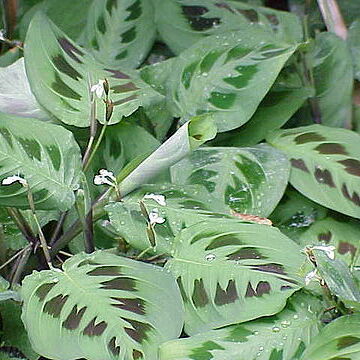Herbs, perennial, from rhizomes. Aerial stems branched or unbranched. Leaves in a basal cluster, both basal and cauline, [or strictly cauline], alternate, differentiated into basal sheath, petiole (occasionally absent), and blade; sheaths often overlapping, supporting stem, open, ligule absent; summit of petiole distinctly differentiated as pulvinus (i.e., region of specialized cells controlling leaf movement, differing in color, often size, from petiole); blade with lateral veins parallel, diverging from prominent midrib. Inflorescences 1--several per aerial shoot, terminal or terminal and lateral on aerial stem [occasionally arising directly from rhizome], scapose or pedunculate [subsessile], compound, headlike or spikelike to diffuse or much branched, bracteate; each bract enclosing pair of flowers or cincinnus of paired flowers [solitary flowers (Monotagma, Monophrynium)]. Flowers bisexual, asymmetric, paired flowers mirror images of each other; sepals and petals differentiated, sepals 3, distinct [rarely connate basally (Megaphyrnium)], petals 3, corolla, staminodes, and style fused basally into tube; fertile stamens 1, occasionally petal-like; anthers 1-locular; staminodes [2--]3--4, outer staminodes [0--]1--2, petal-like, inner staminodes 2, one fleshy (callose staminode), one hooded (cucullate staminode), bearing 1(2 in Thalia) appendage(s), subterminal or medial, fingerlike or flaplike; ovary inferior, 3-carpellate, 3-locular, 1[--3] locule(s) fertile; placentation basal; ovules 1 per locule; terminal portion of style and stigma enclosed in cucullate staminode, explosively released, stout (appendaged in Thalia); stigma cup-shaped. Fruits fleshy [dry] capsules (rarely indehiscent) [berry or achene]; sepals often persistent in fruit. Seeds: aril present [rarely absent]; endosperm scanty or absent; perisperm copious; embryo curved.
Perennial herbs with rhizomes, sometimes with bamboo-like shoots. Shoots simple or branched with one to many leaves. Leaves with petiole sheathing below, terete in the middle and both terete and calloused (pulvinate) just below the blade; leaf-blade usually more or less asymmetric with one side (either left or right) more curved than the other and the acumen not in line with the midrib; some plants with only one type of leaf (the more curved side either right or left) (homotropic), some with both types (antitropic); nerves parallel and very numerous. Inflorescence simple or branched with each cymose partial inflorescence in the axil of a primary bract, each successive branch of the cyme (a two-flowered cymule) enclosed in an unkeeled or 2–3-keeled prophyll, and an unkeeled mesophyll opposite the prophyll, or with mespohyll or both mesophyll and prophyll absent; primary bracts arranged in simple spikes with from 4 to many nodes. Cymule pedunculate or sessile with the two flowers pedicellate or seesile, side by side or at different levels, with or without fleshy bracteoles. Sepals free, equal. Corolla forming a tube below with 3 petaloid lobes. Staminodes (with stamen) forming a tube below, which is fused to the corolla tube; outer staminodes 2 or 1, petaloid or subulate, sometimes unequal; inner staminodes 3, unequal, one bearing the anther and another hooded, with or without a spur-like appendage. Style and stigma at first held erect by the hood of one of the staminodes, later suddenly bending downwards. Ovary inferior, 1-or 3-locular with one ovule in each loculus. Fruit dehiscent or indehiscent, with 1–3 seeds. Seed with or without a basal aril; endosperm abundant
Herbs perennial, rhizomatous. Aerial stems present or absent. Leaves distichous, usually large; petiole sheathing at base, apex with a swollen pulvinus; leaf blade pinnately veined, lateral veins parallel, slightly S-shaped. Inflorescences terminal or axillary, borne on leafy shoots or occasionally on separate, leafless shoots from rhizomes, compound, headlike, spicate, or diffuse and much branched, bracteate; bracts each subtending a pair of flowers or a cincinus of paired flowers. Flowers bisexual, asymmetric, paired or rarely borne singly. Sepals 3, free. Corolla lobes 3, often slightly unequal, basally connate into a tube. Staminodes and stamen in 2 whorls: outer whorl with 1 or 2 petaloid staminodes, rarely absent; inner whorl with 1 hooded (cucullate) staminode enclosing terminal portion of pistil at anthesis and bearing a lateral appendage (trigger), 1 thickened and fleshy (callose) staminode, and 1 fertile stamen narrowly petaloid laterally; anther 1-loculed. Ovary inferior, 3-loculed, 1--3 locules fertile; ovules 1 per locule. Style cylindric, adnate to inside of corolla and staminode tube, free portion curved after explosive forward movement (tripping) when released Seeds 1--3, hard, usually arillate.from hooded staminode; stigma scoop-shaped or blunted and 3-cleft. Fruit a capsule, loculicidal, rarely indehiscent or berrylike.
Leaves in two rows, differentiated into an open sheath, stalk and blade, the stalk often winged, but terete and pulviniform towards the apex, this being referred to as the calloused portion (see Fig. 345), the blade sometimes with one straight and one curved side, with closely parallel numerous nerves diverging obliquely from the midrib
Perianth mostly differentiated into calyx and corolla; outer segments free, inner more or less tubular, divided into 3 mostly unequal parts
Flowers bisexual, asymmetric, in a terminal bracteate spike or panicle, or the inflorescence arising from the rhizome
Ovary inferior, 3-1-locular, sometimes 2 of the loculi infertile; style stout, often dilated at the apex
Seeds with abundant endosperm and much incurved or folded embryo, and often with an aril
Fertile stamen 1; anther 1-locular; staminodes variously petaloid
Fruit fleshy or a loculicidal capsule
Ovule solitary, erect
Perennial herbs

